To Katie, Henry, Mike and Neil (I will explain later),
I have a twitter account Per at RollaOne (@roll_a_one) were I ran a vote on whether to do a Christmas game with Swedes fighting Danes or Saxons. Here are the results. Being Swedish I did not want to us to do a game without the Swedes on the table. It would have been a strange Great Northern War battle without them anyway.
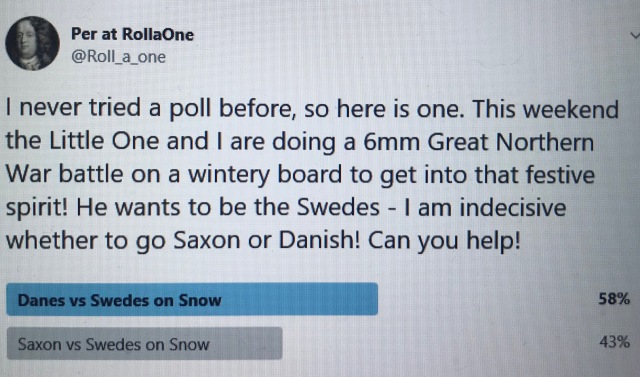
So here a presentation of the forces and a short AAR with some picture of the Battle…
The Rules, Opposing Commanders and their Forces
We decided to use the Maurice Rules for the game and made two 100-pointish armies each. 1 unit is represented by 2 No. 60 by 30mm bases (a battery by 1 No. smaller base) – normally you use 4 square bases for a unit – this is 2 bases – the only issue is that the column formation looks funny – I can live with that.
 Maurice is an excellent game by Sam Mustafa and you can download some information on his webpage, including a lite version that you can play with (link here). The rules works well for us and suits the way we play.
Maurice is an excellent game by Sam Mustafa and you can download some information on his webpage, including a lite version that you can play with (link here). The rules works well for us and suits the way we play.
We have not done a what-if, instead it is a just a battalion level clash with familiar names of regiments for both sides, but with two totally fictitious Generals (quickly sketched up by yours truly).
I am using Maurice because I would like to do a little campaign, at some point, of the Swedish lacklustre efforts against the Prussians during the Seven Years War. This is a chance to dust off these rules that I think gives a fun flair and works for the Period. It is a card driven system, cards are used for activation and in additon can give bonus to firing (called Volley in the game), actions (charge, march, bombard, rally) or events can be played. You can also buy national advantages that gives your army bonuses. There is also a good campaign system, heroes (notables that work as supporting Commanders) and other stuff not covered here.
I made some notes on Maurice earlier with regards to the Great Northern War era (link to that blog post here). In addition we are using the special rules for stationary artillery and pikes (for the Swedes).
This is not a review of the rules and I will just discuss the set-up and the result of the Battle briefly, there are a lot of reviews and playthroughs on the net, as the game has been around for some time, that you may want to check out. I really like the concept and the card system. As you will see in the actual game we played it creates a narrative.

The Danish Side
The Danish Major General Schmeicel is a tired and laconic individual, but can cause some occasional spark on the battlefield. He is mainly an infantry specialist and have fought many campaigns in central Europe and his men are well drilled in firing – in accordance with the Dutch School. This places less emphasis on the bayonet and is highly dependent on platoon firing with a rippling of fire down the whole length of the battalion. His strength lies in a prolonged firefight again the inferior firing Swedish units but will find it difficult once caught in the melee. The conscript horse units are represented by Dragoons.

For the Danish side we went for the following:
- National Advantage: Lethal Volleys – 12 AP (this to represent better fire drill than the charge oriented Swedes)
- 8 No. Regular Infantry (Trained) Units – 48 AP
- 2 No. Regular Cavalry (Trained) – 12 AP
- 3 No. Regular Cavalry (Conscript) – 12 AP
- 4 No. Artillery units – 10 AP
- Improve two units to Elite – 5 AP (1 No. Cavalry and 1 No. Infantry)
- A total of 99 AP, 16 infantry bases, 10 cavalry bases and 4 Artillery bases.
We are also assuming Stationary batteries for the Artillery (See Chapter 10 – advanced rules). In this era
Resulting in the following force:
- Foot Guard/Queens Req, Regular Infantry, Elite
- Grenadiers, Regular Infantry, Trained
- Marine Regiment, Regular Infantry, Trained
- Frijs Regiment, Regular Infantry, Trained
- Arnoldts, Regular Infantry, Trained
- Zepelin Regiment, Regular Infantry, Trained
-
Staffels/Kragh, Regular Infantry, Trained
- Viborg/Aarhus National, Regular Infantry, Trained
- Horse Guard, Regular Cavalry, Elite
- 2nd Fynske, Regular Cavalry, Trained
- Life Dragoon, Regular Cavalry, Conscript
- Bulow Dragoon, Regular Cavalry, Conscript
- Jyske Land Dragoon, Regular Cavalray, Conscript
- 1 to 4 Artillery Units
The Swedish Side
The Swedish Major General Stryptagh has risen quickly through the ranks and is one of the Kings youngest Generals. Keen to impress, he is rash and a fully aligned with the Swedish offensive tactical doctrine (Gå-På). He needs to get into contact as quickly as possible to win the day with superior shock cavalry as well as pike armed infantry units, hitting hard. The religious doctrine is represented in the use of clerics which is more to give an edge than clerics running around throwing incence. The cleric will be marked using individually bases figures. There is no difference between Cavalry and Dragoons in the Swedish army in this game, or in reality, the are all count as galloping shock attacking cavalry.
As elegantly described in the book “Vägen till Poltava” (‘The Road to Poltava’, by Konovaltjuk and Lyth) the Swedish doctrine of marching slowly and steadily, towards the enemy in silence, then fire a Salvo at 70 steps and then at 30 steps from the enemy, with no reloading, before charging in, was based on simple mathematics.
Here is a rough translation of the relevant passage.
“The Swedish method of infantry attack was based on the limited accuracy (spread) of musket fire and the time to reload for a new salvo. The spread meant that units preferred to shoot at the same time with many weapons – salvo fire – and hoped this would create gaps in the human wall in front of them, even though many shots failed to ignite or missed their targets. A salvo had a limited impact on distances above 70 steps (50 meters) – except against cavalry that had a bigger target area and were the horses reaction was more important than the riders. In shooting repeated salvos, whether they were fired by rank, platoon or by all, you had to wait for all to reload. The time for unified reloading has been discussed a lot and sometimes assessed to be at least one minute and up to two minutes. In a minute the enemy had time to march one hundred steps (75-80 meters) and run 150 steps. If the effective range for a salvo was 70 steps the unit that opened fire at a longer distance became a defenceless target for the opponent that calmly and steadily advanced and fired its salvo at a shorter distance and therefore with a bigger impact. The Gå-På method was based on this simple calculation.”
In reality it seems that the first and second salvos were fired even closer as the war progressed. It was very effective and very often led to a routing enemy at or before contact with no protracted melee. The horse charged in with a wedge shaped formation as was equally offensive and did normally not fire any weapons at all.
For the Swedish side we went for the following:
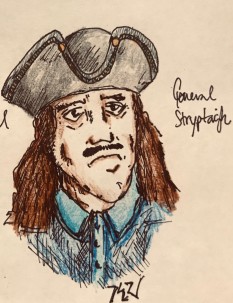
- Major General Stryptagh
- National Advantage: Cavaliers – 9 AP (Shock Cavalry), Clerics – 9 AP (to illustrate Swedish Determination) and A la Baïonnette! – 9 AP (shock infantry)
- 5 No. Regular Cavalry (Trained) – 30 AP
- 5 No. Regular Infantry (Trained) Units – 30 AP
- Improve four units to Elite – 14 AP (1 No. Cavalry and 3 No. Infantry)
- Also Swedish infantry are armed with pike and we are using the advance rules for Pikes (See Chapter 10 – Advanced Rules). Typically a third of the Soldier had pikes in the early Stages of the War.
- A total of 101 AP. 10 No. Cavalry Bases and 10 No. Infantry Bases.
Resulting in the following force:
- Närke-Varmland, Regular Infantry, Elite
- Västerbotten, Regular Infantry, Elite
- Västermanland, Regular Infantry, Elite
- Kronobergs, Regular Infantry, Trained
- Södermanland, Regular Infantry, Trained
- Queen Dowagers Horse, Regular Cavalry, Elite
- Bremiska Dragoon, Regular Cavalry, Trained
- Bassewitz Dragoon, Regular Cavalry, Trained
- Norra Skanska Cavalry, Regular Cavalry, Trained
- Nylands Cavalry, Regular Cavalry, Trained
We then made our selection from the Winter based stuff, we used about 25% of it.
The Battlefield
We fought the battle on the dining table, using a 3 by 4.5 feet snow mat I have had for some time. With the relative small forces at hand (and a base width at 30mm) this should work fine.
We drew the following battle field card.

Going through the motions of the card we find that we can place a maximum of 1 hill, 2 marshes, 1 rocky ground, 2 towns/village, and 6 wood terrain features (the red around marking around the forest number indicates that it is mandatory to choose some forest features (makes sense since the battles is in a woodland area).
Next was scouting and this is done by rolling a die each. The Little One rolled 6 and I rolled, yes you got it, One!. There are modifiers based on the number of units you have of the type on the card (regular cavalry and irregular infantry in this case) but there was no point checking this, the Little One won. He wanted to be the attacker! – it was what the Swedes did in this era.
We ended up choosing two town/village and a few forest terrain areas. The table was set up as follows.

In addition being the attacker the Little One was allowed an additional ‘mercenary’ units – we just added another Swedish infantry unit.
We then recorded our Army Morale values which were 17 for the Danes and 11 for the Swedes, this is based on number regular of units!
A little bit of shuffling and card allocation later we could start the Battle.
The Battle
The Jingle Bells rang and we were ready to get going….
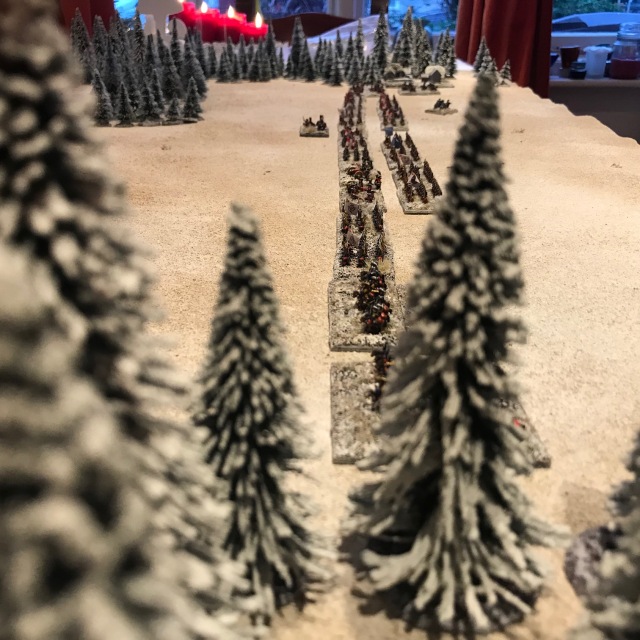
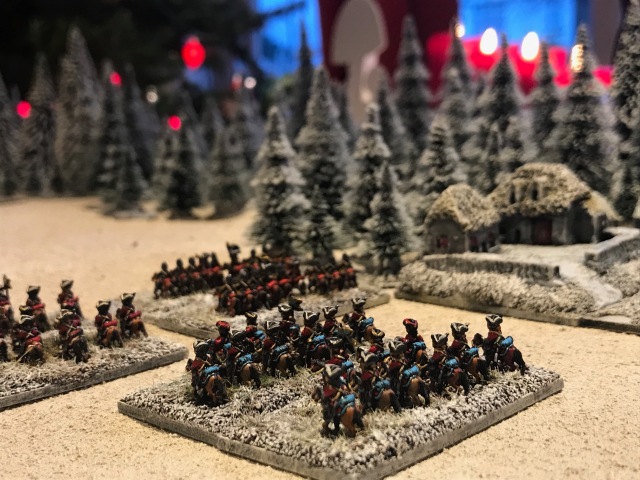




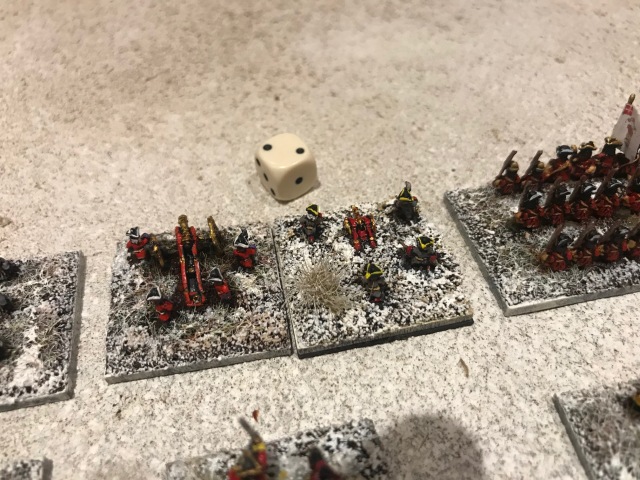








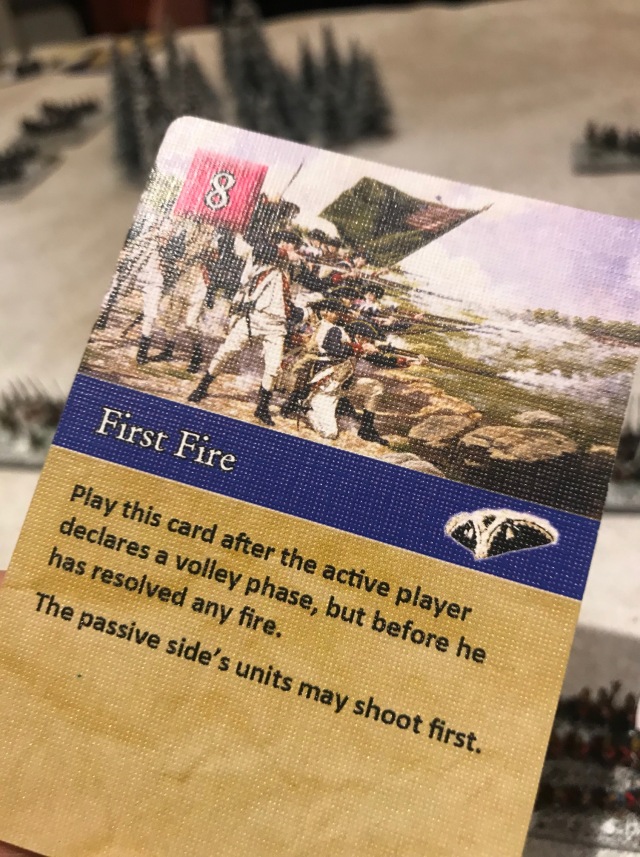


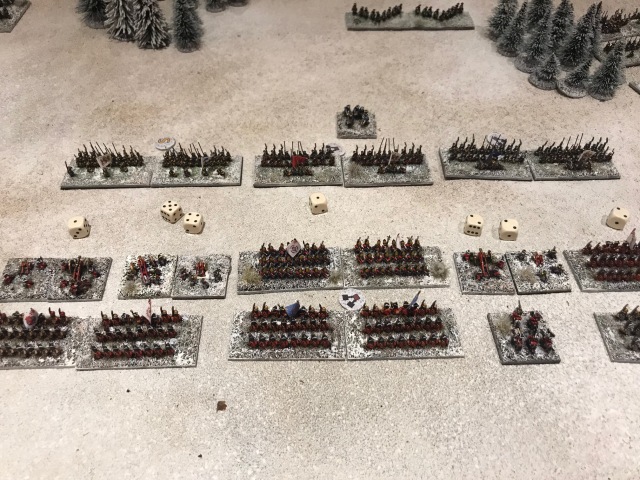

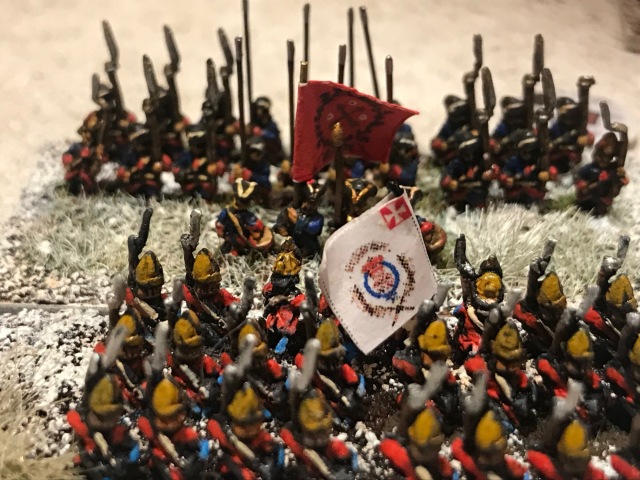


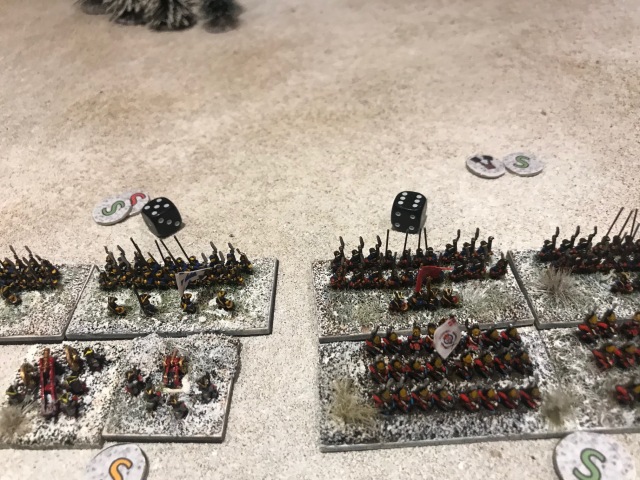


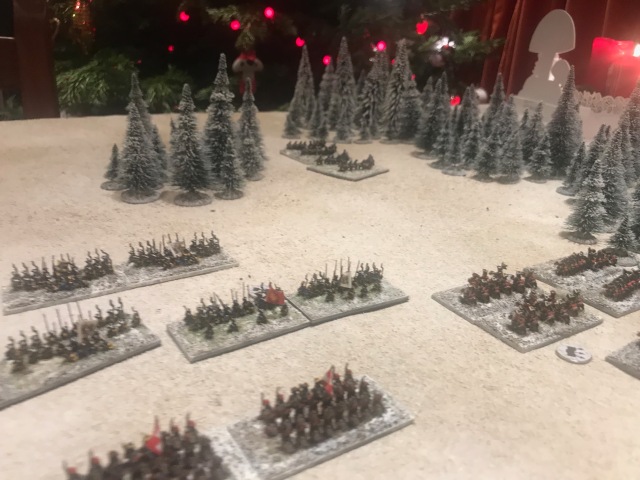
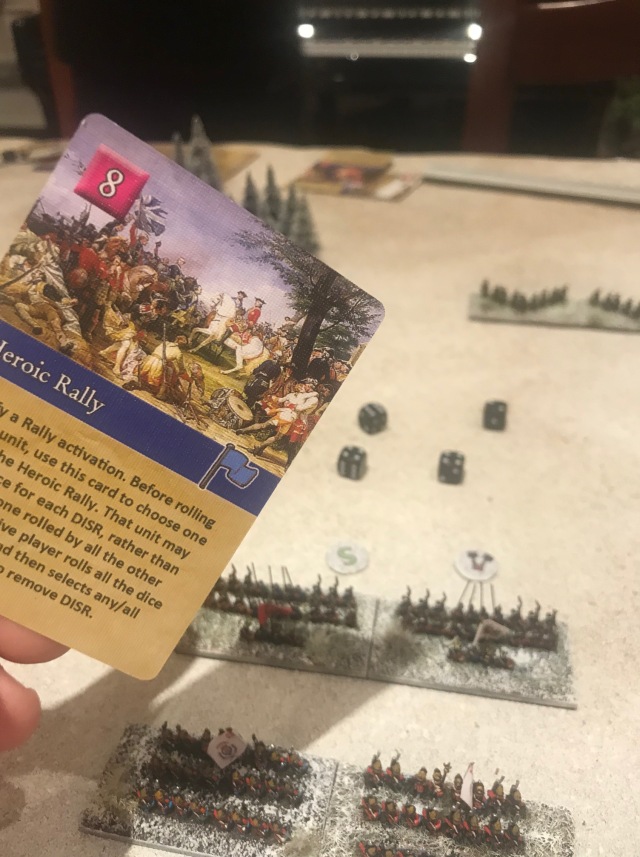


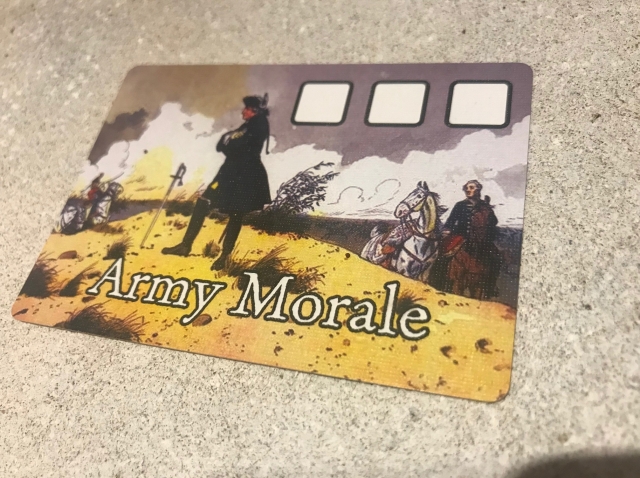
Assessment
The Game got a thumbs up from the Little One. I have to agree, although the write-up perhaps gives the impression of Swedish onslaught it hang somewhat in the balance. The cards are interesting and the national characteristics gives the right Great Northern War feel we get from the traditional history books.

We had blast, but then we always do. I would like to take this opportunity to wish you a really good Christmas if that is your thing, if not have a blast anyway. I will be back with some reflective stuff before the end of the year. That will be the normal review of the Year, from this/my blogs perspective (and there is a wide variety of stuff to cover), and some Crystal ball gazing for next year. Hope you will be back for that! The next big project is Poltava, with some 350 bases on the table (the battle we just presented above had 50 bases) at Joy of Six in July – it will be a spectacle. Here is a “nice” video about the battle from YouTube.
A sad but also, I hope, inspiring end to this post…
Being somewhat detached from worldly events at times, I totally missed that my favourite Danish Artist Kim Larsen died earlier this year, on the 30th September 2018. This was after a long battle with prostate cancer.

I remember many drunken occasions in my youth listening to his band Gasolin and have been listening to him since. I have included my favourite song below – “Det bedste til mig og mine venner” (“The best to me and my friends”).
This year I have also sadly been reminded of the issues of mental health within my family, friends and in the work place. I am happy that the awareness and understanding is increasing in our society but I think there is a lot more to do. In the wargaming community I especially applaud efforts from Katie Aidley, Henry Hyde and the Meeples and Miniatures crew (of course there are others too). They have all in their own way inspired me to reflect, consider and learn new things about these issues. This blog post is truly dedicated to them.
I let you explore the fantastic creative work of these fantastic people on your own, but here is a little bit of help for you to get started.
Katie Aidley – https://katiesgamecorner.com/
Henry Hyde – http://henrys-wargaming.co.uk/
Meeples and Miniatures – https://meeples.wordpress.com/2018/12/13/meeples-miniatures-episode-257-the-devil-in-your-head/
I had a Christmas Greeting from an ex-colleague who retired a few years ago, he said some nice things, and one part really made me happy “…working with you was a pleasure. And I noted you covered by back quite a lot”. He actually covered mine and many others backs all the time. It is what builds strong teams, friendships and people! Look out for each other!, … and yourself!.
Remember, “the best for me and my friends!”.
Rest in peace Kim.



That is a stunning game set up. It really shows what you can do in 6mm.
Cheers,
Pete.
LikeLiked by 2 people
Thanks Pete!
LikeLiked by 2 people
Pingback: 2018 is almost over… – Roll a One
Amazing battle. The cards look fun. Love the snowy trees! Well written blog post, hope you have a happy new year Per!
LikeLiked by 1 person
The same to you Mark!
LikeLiked by 1 person
Great post Per. It inspires me to play some games of Maurice with my Baccus WSS
Thanks for posting it & including the mental health links
LikeLiked by 1 person
Thank you Colin, we really enjoyed the game and few more since. If you do not have the rules try the Lite version first to see if it works for you.
LikeLike
Pingback: What is up next? Great Northern War, Scanian War and some Bonus Pictures of Poltava 1709 – Roll a One